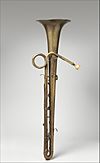Euphonium facts for kids

A euphonium
|
|
| Classification | Brass |
|---|---|
The euphonium is a cool brass instrument. It looks a bit like a small tuba or a big trumpet. It makes deep, rich sounds, similar to a trombone.
This instrument usually has 3 or 4 valves. It also has 1 to 3 "spit valves." Don't worry, these valves don't actually hold spit! They are there to let out condensation, which is just water that builds up inside the instrument from your breath.
You can find the euphonium in many different bands in places like Europe and America. Musicians play it by blowing air into the mouthpiece and "buzzing" their lips. This buzzing makes the air inside the instrument vibrate, creating sound.
The name "euphonium" comes from a Greek word. It means "producing nice sounds." Most euphoniums are shiny silver or brass in color.
Contents
How the Euphonium Came to Be
The euphonium has a long family history! One of its oldest relatives is an instrument called the serpent. This unusual instrument was used for over 200 years, starting way back in the late Renaissance period. But it was quite tricky to play in tune because its finger holes were very small.
The Invention of Valves
Things changed a lot for brass instruments around 1818. That's when the piston valve system was invented! This new invention made it possible to build brass instruments that sounded even and were easier to play.
The euphonium itself is thought to have been invented in 1843 by Ferdinand Sommer in Germany. However, other people like Carl Moritz (in 1838) and Adolphe Sax (also in 1843) are sometimes given credit too.
Modern Euphoniums
A special kind of euphonium, called the "British-style" compensating euphonium, was created in 1874. David Blaikley, from a company called Boosey & Co, developed it. This design has been used in Britain ever since, and its basic shape hasn't changed much.
Today, instrument makers are still working to make euphoniums even better. Companies like Adams and Besson are leaders in this. For example, Adams euphoniums have a special part that lets players change the sound of the instrument. Besson added a way for players to adjust the main tuning slide, which helps them play more in tune.
Images for kids
-
The serpent, an old ancestor of low brass instruments.
-
Amilcare Ponchielli, a composer who wrote one of the first solo pieces for the euphonium.
See also
 In Spanish: Bombardino para niños
In Spanish: Bombardino para niños






